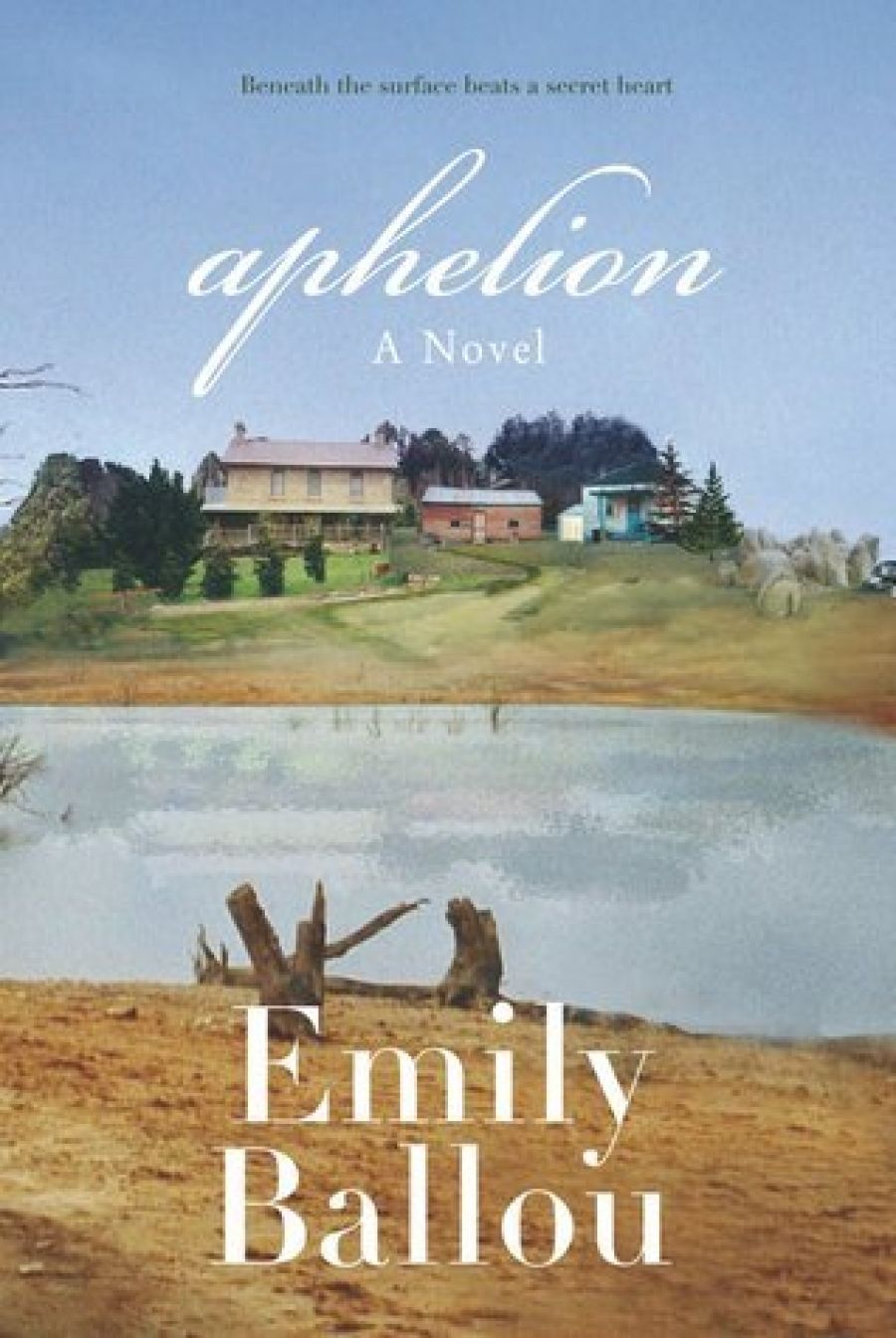
- Free Article: No
- Contents Category: Fiction
- Custom Article Title: Christina Hill reviews 'Aphelion' by Emily Ballou
- Review Article: Yes
- Article Title: The darkest point
- Online Only: No
- Custom Highlight Text:
Aphelion can be called a family epic in that it is long and has many characters. The title of the novel refers to the sun; a character explains that ‘there is a point in astronomy when a planet is at its furthest point from the sun, the slowest point in its orbit. It’s called aphelion. I guess it’s the darkest point.’ In this, her second novel, Emily Ballou uses overlapping and intersecting voices. Six characters – five of them female – contribute to the novel’s complex chorus of memory and reflection over time.
- Book 1 Title: Aphelion
- Book 1 Biblio: Picador, $32.95 pb, 512 pp
Three time frames are used: 1939, 2002 and 1957. In 1939, the shortest section, the old town is as yet undisturbed and the happiness of the Windle family has an almost Arcadian simplicity. Hortense, the mother, is in her thirties, her daughters, Esme and Pictoria, in their teens. With their father, Jack, they go fishing for trout at the river. 2002, the longest section and the ‘now’ of the novel, comes next but is bifurcated by 1957, which narrates the experiences of Hortense, now in her fifties but in her prime and driven by her longing to travel, and of Esme, thirty-five and desperate for love. Esme works as head midwife in the ‘little America’ of Sue City (the location of Australia’s first supermarket), the temporary construction town of the American engineers who live there with their wives and other immigrant labourers. The winter of 1957 is a turning point for both Hortense and Esme. The sudden elopement of Pictoria with a young Italian workman forever alters their lives because she leaves her daughter, five-year-old Byrne, to be raised by them.
In 2002 Hortense is 101, her unmarried daughter Esme is eighty-one and they live in their old house (relocated when the river was flooding) with Pictoria’s estranged daughter Byrne, who is fifty, and single, and her twenty-four-year-old daughter Lucetta. Most of the characters are unhappy or at least disappointed. Hortense, still vibrant and dedicated to the joys of living, is thwarted because she is too old to be allowed to drive a car; Esme, frail, embittered by a life in which so little has happened, is dependent on heavy painkillers and drinks secretly; Byrne believes that her life has been curtailed by her dependent aunt and mother, and Lucetta, widowed four years earlier, works as a vet and tries to manage her grief.
Into this mêlée of rancour, need and disappointment comes Hazel, a thirty-five-year-old American-Australian drawn to the town by the promise of employment as an archivist to establish a memorial planned for the town. She too struggles with her past, a failed love affair in Sydney and her fraught relationship with the mother who is indefatigable in her determination to keep track of the daughter who has escaped to Australia. A young hitchhiker joins Hazel on the way to Adaminaby. This is Rhett, a close neighbour of the Windle family; he is returning to the now empty house of his family, all of whom have died.
All the characters are at the mercy of their own particular demons. Drought dominates the landscape. The lake itself, once at least eighty metres deep and very cold, is now half as deep, but always filthy and dark. The lake and the submerged town become metaphors for all that is lost but forever retained in the psyches of the characters. Rhett, unable to face the ghosts of his now deserted family home, goes diving:
Below, the old town lay, waiting, breathing water. He pointed his torch. Then he was gone. Down to the homesteads that might give way around him if he swam through; down to where the drowned beds were lit with voices, writhing with ghosted lovers; down to the memory of bodies through doors, floorboards and corridors, people calling to each other, laughing, weeping. Maybe if he stayed down long enough this time he could travel back along the anchor line of his mother’s voice, back to her own childhood, follow it through windows and squares of walls to find her, warm and whole, with hands that could actually touch him.
There is much to admire in this novel. The 1957 section is especially powerful; it brings the grand narrative of the heroic, almost mythic construction of the dam to life. Ironically, the mindset of unquestionable progress that went with it seems tragically naïve today, though this is not explored. While landscape and history are strongly realised in the novel, Ballou has attempted too much. The plot seems unnecessarily convoluted, and this is exacerbated by the narrative trick of withholding information. Less is more. Aphelion is too long.


Comments powered by CComment